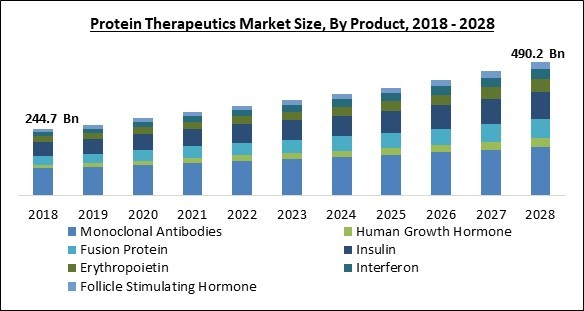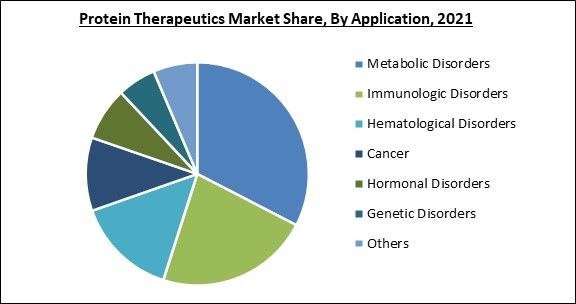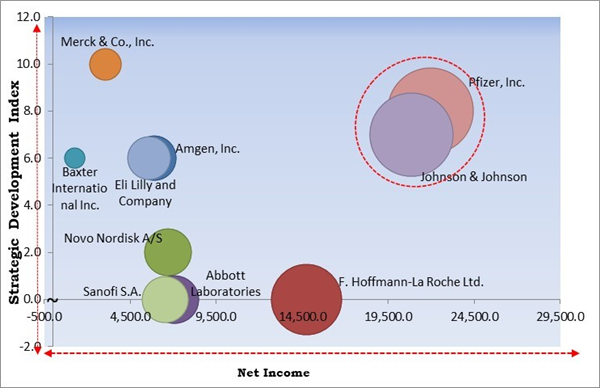The Global Protein Therapeutics Market size is expected to reach $490.2 billion by 2028, rising at a market growth of 6.9% CAGR during the forecast period.
Protein therapeutic medicines are a class of pharmaceuticals used to treat a range of illnesses, including cancer, metabolic, hematological, immunological, hormonal, genetic, contagious diseases, and others. These medications could greatly enhance human health. Protein distribution in appropriate amounts to the body to enable the precise functioning of various glands, as well as other organs in the body, is the basic concept behind protein therapy, which is conceptually related to gene therapy.
Genetically modified versions of naturally produced human proteins are called therapeutic proteins. They can be utilized to swap out proteins that are defective or lacking in a particular condition. They can also increase the supply of a helpful protein, which helps lessen the effects of chemotherapy or sickness. The proteins produced by genetic engineering can be made to closely match the natural proteins they are meant to replace, or they can be improved by the addition of sugars and other compounds that prolong the protein's activity.
A protein that is defective or lacking in a certain condition can be replaced with therapeutic proteins. They can also increase the body's production of a helpful protein to lessen the effects of illness or chemotherapy. The proteins produced by genetic engineering may closely resemble the natural proteins they are intended to replace, or they may be improved.
The major strategies followed by the market participants are Acquisitions. Based on the Analysis presented in the Cardinal matrix; Johnson & Johnson and Pfizer, Inc. are the forerunners in the Protein Therapeutics Market. Companies such as Merck & Co., Inc. Amgen, Inc., Eli Lilly and Company are some of the key innovators in Protein Therapeutics Market.
The market research report covers the analysis of key stake holders of the market. Key companies profiled in the report include Abbott Laboratories, Baxter International, Inc., Amgen, Inc., F. Hoffmann-La Roche Ltd., Eli Lilly and Company, Merck & Co., Inc., Johnson & Johnson (Janssen Global Services, LLC), Pfizer, Inc., Novo Nordisk A/S and Sanofi S.A.
Protein therapeutic medicines are a class of pharmaceuticals used to treat a range of illnesses, including cancer, metabolic, hematological, immunological, hormonal, genetic, contagious diseases, and others. These medications could greatly enhance human health. Protein distribution in appropriate amounts to the body to enable the precise functioning of various glands, as well as other organs in the body, is the basic concept behind protein therapy, which is conceptually related to gene therapy.
Genetically modified versions of naturally produced human proteins are called therapeutic proteins. They can be utilized to swap out proteins that are defective or lacking in a particular condition. They can also increase the supply of a helpful protein, which helps lessen the effects of chemotherapy or sickness. The proteins produced by genetic engineering can be made to closely match the natural proteins they are meant to replace, or they can be improved by the addition of sugars and other compounds that prolong the protein's activity.
A protein that is defective or lacking in a certain condition can be replaced with therapeutic proteins. They can also increase the body's production of a helpful protein to lessen the effects of illness or chemotherapy. The proteins produced by genetic engineering may closely resemble the natural proteins they are intended to replace, or they may be improved.
COVID-19 Impact Analysis
The COVID-19 pandemic severely hampered the economy all over the world. A number of businesses were significantly demolished by the abrupt emergence of the pandemic. Moreover, several manufacturing and production facilities were closed owing to the outbreak due to the lockdown imposed by various governments within their countries. The protein therapeutics market was also disrupted in the initial period of the pandemic. Lockdown caused major delays within the development and delivery of crucial medical supplies. Attributed to this, the production of therapeutic protein was impeded.Market Growth Factors
An increase in the cases of cancer across the world
One of the major factors that are driving the growth of the protein therapeutics market is the expansion in the prevalence of various types of cancer all over the world. Any disease that can affect any region of the body is referred to as cancer. Neoplasms and malignant tumors are other words that are used to denote this disease. One characteristic of cancer is the quick development of aberrant cells that expand outside of their normal borders, infiltrate other body components, and eventually move to other organs. This process is known as metastasis. The main reason why cancer patients die is because of widespread metastases within their bodies.Rising focus of governments and regulatory bodies in accelerating the process of approval for this practice
A significant number of people in various developed, as well as developing nations who suffer from uncommon and complex diseases, depend on plasma-derived therapies every day as essential, life-saving medications. The need for these treatments, in particular immunoglobulins, has grown significantly and is still growing on a global scale. Plasma-derived therapies are treatments made from human plasma through a fractionation procedure in which the pertinent plasma proteins are isolated. The single largest component of human blood is called plasma, which is made up of proteins, salts, enzymes, and water. Primary and secondary immunodeficiencies, bleeding disorders, inhibitor deficiencies, and other rare diseases are all treated with plasma-derived medicines.Market Restraining Factors
High manufacturing and administration cost
A major challenge in the growth of the protein therapeutics market is the high cost of protein therapies. Because of high product prices, some therapies that patients need for a speedy and complete recovery are no longer available. In several nations, prices are additionally governed by law. Through their authority over national healthcare organizations, which can cover a significant portion of the cost of distributing drugs to consumers, government bodies restrict costs.Product Outlook
On the basis of Product, the Protein Therapeutics Market is segmented into Monoclonal Antibodies, Insulin, Fusion Protein, Erythropoietin, Interferon, Human Growth Hormone, and Follicle Stimulating Hormone. In 2021, the Insulin segment garnered a significant revenue share of the protein therapeutics market. The rise in the growth of the segment is majorly attributed to the increasing cases of diabetes all over the world. Insulin is a natural hormone, which is produced by the pancreas. The lack of production of this hormone is the factor that stimulates the diabetes level of the human body.Application Outlook
By application, the Protein Therapeutics Market is segregated into Metabolic Disorders, Immunologic Disorders, Hematological Disorders, Cancer, Hormonal Disorders, Genetic Disorders, and Others. In 2021, the metabolic disorders segment procured the biggest revenue share of the protein therapeutics market. The rise in the growth of the segment is due to the exponential demand for high-quality medications and adaptable therapies for the treatment of diseases, particularly diabetes, which is anticipated to support the segment's growth.Regional Outlook
Region-wise, the Protein Therapeutics Market is analyzed across North America, Europe, Asia-Pacific, and LAMEA. In 2021, North America held the largest revenue share of the protein therapeutics market. This is ascribed to an increase in the incidence of chronic diseases, the use of cutting-edge treatments, the presence of important players, and an increase in healthcare spending in the area. Moreover, North American countries are early adopters of several new technologies and approaches.Cardinal Matrix - Protein Therapeutics Market Competition Analysis
The major strategies followed by the market participants are Acquisitions. Based on the Analysis presented in the Cardinal matrix; Johnson & Johnson and Pfizer, Inc. are the forerunners in the Protein Therapeutics Market. Companies such as Merck & Co., Inc. Amgen, Inc., Eli Lilly and Company are some of the key innovators in Protein Therapeutics Market.
The market research report covers the analysis of key stake holders of the market. Key companies profiled in the report include Abbott Laboratories, Baxter International, Inc., Amgen, Inc., F. Hoffmann-La Roche Ltd., Eli Lilly and Company, Merck & Co., Inc., Johnson & Johnson (Janssen Global Services, LLC), Pfizer, Inc., Novo Nordisk A/S and Sanofi S.A.
Strategies deployed in Protein Therapeutics Market
; Partnerships, Collaborations and Agreements:
- Aug-2022: Merck came into a collaboration with Orna Therapeutics, a biotechnology company. Following this collaboration, the companies is expected to work on the discovery, development, and commercialization of multiple programs, encompassing therapeutics and vaccines in the sector of infectious disease and oncology.
- Mar-2022: Novo Nordisk joined hands with Massachusetts Institutes of Technology and Brigham and Women’s Hospital. Through this collaboration, the company aimed to leverage the distinct prospect to bring new transformational solutions to patients by utilizing its distinct capabilities.
- Jan-2022: Amgen teamed up with Amgen Generate Biomedicines, a therapeutics company. Under this collaboration, the companies aimed to develop and manufacture protein therapeutics to address 5 clinical ailments.
- Jan-2022: Merck teamed up with Absci, the drug, and target discovery company. Following this collaboration, Merck aimed to leverage Absci’s platform to utilize its compelling opportunity intending to develop new biologic candidates as well as explore complex protein expression.
- Aug-2021: Eli Lilly and Company joined hands with Lycia Therapeutics, a biotechnology company. Following this collaboration, the companies aimed to focus on the development, manufacturing, and marketing of new targeted therapeutics leveraging the proprietary lysosomal targeting chimera protein degradation technology of Lycia.
- Sep-2020: Merck collaborated with Seattle Genetics, an American biotechnology company. With this collaboration, the companies aimed to further expand the oncology portfolio of Merck in order to enhance the lives of cancer patients.
; Acquisitions and Mergers:
- Jun-2022: Pfizer took over ReViral, a privately held, clinical-stage biopharmaceutical company. Through this acquisition, the company aimed to integrate RSV investigational treatments of ReViral into its portfolio in order to acquire an offering of promising therapeutic candidates.
- Nov-2021: Pfizer took over Trillium Therapeutics, a clinical-stage immuno-oncology company. This acquisition aimed to offer an impressive portfolio, including biologics, to Pfizer
- Jul-2021: Amgen took over Teneobio, a clinical-stage biotechnology company. With this acquisition, the company aimed to leverage Teneobio's antibody platform in order to complement its prevailing capabilities. Moreover, the company also aimed to gain a diverse range of building blocks that can be created into new multispecific therapeutics.
- Jul-2021: Eli Lilly and Company completed its acquisition of Protomer, a pre-clinical stage biotechnology company. Under this acquisition, the company aimed to help Protomer in enhancing its diabetes range with its innovative technology.
- Feb-2021: Merck took over VelosBio, a privately held clinical-stage biopharmaceutical company. Through this acquisition, the company aimed to boost its expanding oncology portfolio while also strengthening its long-term growth potential.
- Aug-2020: Johnson & Johnson completed its acquisition of Momenta Pharmaceuticals, a biotechnology company. This acquisition aimed to strengthen Janssen’s position in the autoimmune diseases sector and offer a major catalyst for sustained growth of the company.
; Approvals and Trials:
- Sep-2020: Baxter International received the US FDA approval for its Clinimix and Clinimix E. The new formulations aimed to complement the offerings of medical formulations with their higher protein content.
Scope of the Study
Market Segments Covered in the Report:
By Product
- Monoclonal Antibodies
- Human Growth Hormone
- Fusion Protein
- Insulin
- Erythropoietin
- Interferon
- Follicle Stimulating Hormone
By Application
- Metabolic Disorders
- Immunologic Disorders
- Hematological Disorders
- Cancer
- Hormonal Disorders
- Genetic Disorders
- Others
By Geography
- North America
- US
- Canada
- Mexico
- Rest of North America
- Europe
- Germany
- UK
- France
- Russia
- Spain
- Italy
- Rest of Europe
- Asia Pacific
- China
- Japan
- India
- South Korea
- Singapore
- Malaysia
- Rest of Asia Pacific
- LAMEA
- Brazil
- Argentina
- UAE
- Saudi Arabia
- South Africa
- Nigeria
- Rest of LAMEA
Key Market Players
List of Companies Profiled in the Report:
- Abbott Laboratories
- Baxter International, Inc.
- Amgen, Inc.
- F. Hoffmann-La Roche Ltd.
- Eli Lilly And Company
- Merck & Co., Inc.
- Johnson & Johnson (Janssen Global Services, LLC)
- Pfizer, Inc.
- Novo Nordisk A/S
- Sanofi S.A.
Unique Offerings from the Publisher
- Exhaustive coverage
- The highest number of Market tables and figures
- Subscription-based model available
- Guaranteed best price
- Assured post sales research support with 10% customization free
Table of Contents
Chapter 1. Market Scope & Methodology
Chapter 2. Market Overview
Chapter 3. Competition Analysis - Global
Chapter 4. Global Protein Therapeutics Market by Product
Chapter 5. Global Protein Therapeutics Market by Application
Chapter 6. Global Protein Therapeutics Market by Region
Chapter 7. Company Profiles
Companies Mentioned
- Abbott Laboratories
- Baxter International, Inc.
- Amgen, Inc.
- F. Hoffmann-La Roche Ltd.
- Eli Lilly And Company
- Merck & Co., Inc.
- Johnson & Johnson (Janssen Global Services, LLC)
- Pfizer, Inc.
- Novo Nordisk A/S
- Sanofi S.A.
Methodology

LOADING...











